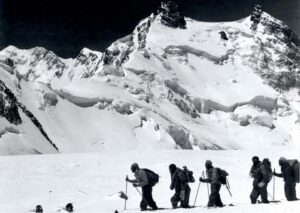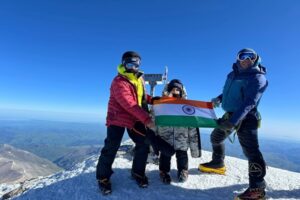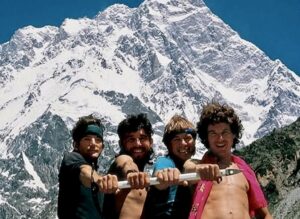On the early afternoon of April 25, 2015, a 7.8 earthquake shook Nepal and neighboring countries.
High in the Himalaya, the event triggered a cacophony of avalanches that extended from Pumori eight kilometres to the west through Mount Everest Base Camp. The snowshed pummeled Everest climbers, claiming 18 lives in an instant and trapping dozens of others.

Photo: Galyna Andrushko
2015 Everest disaster
Among those caught in the tumult were British reporter Tom Martienssen and his team of British Army Gurkhas. Though not immediately killed, there was no guarantee that they’d survive. The quake had sequestered the group between barricades of rock and ice at 6,100m.
“It’s 11:50 am on 25 April when the Earth starts to move beneath my feet,” Martienssen later recounted. “There are 500m-deep crevasses immediately behind me, three of the world’s tallest mountains in front — and a crackling rumble accelerating through the mist, getting rapidly closer.”
Having lived through the event, Martienssen later told the tale in this brief documentary from the BBC.

Photo: Ilker Ender
” ‘Stay calm, stay calm. Prepare to run!’ my guide Rob Casserley’s words reach me through a curtain of fear. I am truly petrified,” reported Martiessen. “Later I discover that three of our group’s Sherpas are among [those] killed when an avalanche ripped through Base Camp.
“The earthquake has killed thousands more below them. Whole villages have been wiped off the map in remote areas of Nepal — many covered by landslides — and some neighborhoods of the capital Kathmandu have been reduced to rubble.”
Matthiessen and the other surviving members of his contingent lived through 48 gutting hours before a rescue helicopter found its way to them.
“[The] helicopter takes me back to Base Camp, where the bodies of the dead lie covered by orange canvas. I have to go back to the UK but there’s one thought on my mind: I want to meet the families of the dead Sherpas left behind.”

Everest Base Camp. Photo: Jum Ruji
A reporter’s duty
After three weeks of recuperation back home, Martiessen returned to the mountain that almost took his life. There he met up with Gurka warrant officer, Govinda Rana. At that time, Rana had served the British Army for 23 years and was commissioned as an Everest summit officer.
The two drove through Nepal for two days toward the remote village of Priti. It would be the first time that Priti received aid since the calamitous event.
“A recce team is sent further into the wilderness to check on the 1,400 houses in the surrounding area. The results are staggering — not a single one is safe to live in. Water supplies are failing and a bridge has collapsed.”
Martienssen helped the Gurkhas hand out a limited supply of corrugated steel material to the villagers to protect their structures from the impending monsoons. He noted that there wasn’t enough to go around. Many families had to wait longer for another supply delivery.
He then visited the home of Kumar, a Sherpa lost in the avalanche. Kumar’s family lived in Cheskum, “a place so remote that helicopter is the only realistic way for me to get there,” he explained.

Rescue helicopter over the Khumbu Icefall. Photo: Vadim Petrakov
The lost Sherpa was survived by his wife, Pancha, and their four children. “Kumar…never stopped smiling…Pancha never stops working.”
After a few days of staying with the family, helping around the farm, and collecting their memories, Martiessen moved on to Kathmandu. There he sought out the family of another Sherpa, Tensing. He met up with Tensing’s widow, Pema, and two “boisterous” boys. Tensing’s income was vital, Pema told the reporter. Not wanting her sons to follow their father’s footsteps as guides, she was faced with the likely reality of having to sell their home to pay for the boys’ education.
At the end of his stay in Kathmandu, Martienssen admitted, “The monsoon is coming — there will be three months of rain and hundreds of thousands of people still have nowhere to live. I admire the resilience of the Nepalese people, but I can’t help but think the toughest challenges may still be to come.”
Follow Martienssen in his humanitarian scribe’s quest to document one of the mountain’s most earth-shattering events in Disaster on Everest.
Runtime: 30 minutes






